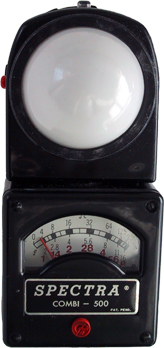
|
  Maker: Photo Research / Spectra Model: Combi-500 Circa: 1963 Price (new): $127.50 Cell type: Selenium and CdS Measure type: 2D and 3D incident Original Battery: 1.34v Mercury Modern Battery: n/a Modern Photography Magazine Review:April 1962 |
|
PR didn't spend a lot of energy on engineering the look of their meters: they kept this design for decades. Their expertise went into the innards of the machine. At this time (around 1963), the Professional was the base model and still used a selenium photocell, and cost just under $100. [For a comparison, at that time the Sekonic L-28 Studio Meter was $30 and a Weston Master IV was $35]. This Combi-500 was $127.50, and the extra money got you CdS (not instead, also). CdS cells were particularly good in low-light but adjusted slowly in bright light. Since the Spectras were marketed to cinematographers and high-end studio photographers, having the dual cells gave them the best of both worlds. This one is a Combi-500, so it has the CdS cell too. They both inhabit the "eye" area under the dome. The CdS cell is for low light work, and you engage it by pressing a button on the side of the unit. Unfortunately it takes 1.34v mercury batteries which are no longer made, and the "equivalents" aren't the right voltage, so if you want to use the CdS, you have to see about buying special batteries or having it professionally recalibrated. Fortunately (at least on mine) the selenium cell still works. This guy shares two distinct similarities with its brother, the Norwood Director. First is that they both have that revolving photo-cell top. They both have about a 300° sweep so you can aim the sensor and still hold the meter face at an angle where it can be read. The other common feature is the use of perforated metal "slides" which slip into a holder just above the photocell. The slides are drilled with holes to let in a fraction of the available light, and are calibrated so that when you place a particular slide in, you can "direct read" the aperture scale. These meters were originally designed and optimized for cinematographers who shoot with movie cameras that have a set 1/50th shutter speed, and the use miles of the same film stock with the same exposure index, so the idea of being able to pick out the proper slide and drop it into the meter and automatically set it was a nice feature to have—no more accidentally changing the calculator dial settings and not noticing. No more having to look at the meter scale and then back to the calculator dial for some mental gymnastics. Or you can use the slides as light multipliers to change the sensitivity scale. Use one slide with big holes for normal light levels, one with small holes for very bright light, or no slide at all for dim light. Ergonomic it is not: it's chunky and goofy-looking and not at all elegant like the Norwood Model B. But it was made for professionals to last. And (at least) this one has. |
|
©opyright by James Ollinger. All Rights Reserved.
Company names and models are registered trademarks of their respective owners
and are not affiliated with this website in any way.

-sm.jpg)